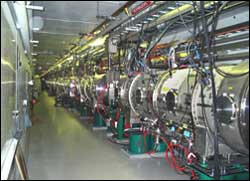This area deals with the fundamental laws and building blocks of nature and how they interact, the properties and the behavior of matter, and research into space and time and their structures.
innovations-report provides in-depth reports and articles on subjects such as astrophysics, laser technologies, nuclear, quantum, particle and solid-state physics, nanotechnologies, planetary research and findings (Mars, Venus) and developments related to the Hubble Telescope.

MAKS 2005 – the biennial Russian International Aviation and Space Salon – is being held in Zhukovsky, close to Moscow, from 16 to 21 August. Space exploration has a prominent role at MAKS 2005 as for the first time the Russian Federal Space Agency, as well as ESA, are exhibitors.
All together 42 countries, 130 foreign aerospace companies and 500 Russian companies. are taking part in the air show. ESA’s presence is a sign of the growing cooperation between ESA and Russia marked

A team of researchers from the Ecole Polytechnique Fédérale de Lausanne (EPFL) has successfully demonstrated, for the first time, that it is possible to control the speed of light – both slowing it down and speeding it up – in an optical fiber, using off-the-shelf instrumentation in normal environmental conditions. Their results, to be published in the August 22 issue of Applied Physics Letters, could have implications that range from optical computing to the fiber-optic telecommunications industry

The Spallation Neutron Source at the Department of Energy’s Oak Ridge National Laboratory has met a crucial milestone on its way to completion in June 2006 — operation of the superconducting section of its linear accelerator.
The SNS linac has two sections: a room-temperature, or warm, section, which completed its commissioning last January, and a superconducting, or cold, section, which operates at temperatures hundreds of degrees below zero. The cold linac provides the bulk of

Numerous electronic, optical and structural uses demonstrated; Advance reported in Aug. 19 issue of prestigious journal Science
University of Texas at Dallas (UTD) nanotechnologists and an Australian colleague have produced transparent carbon nanotube sheets that are stronger than the same-weight steel sheets and have demonstrated applicability for organic light-emitting displays, low-noise electronic sensors, artificial muscles, conducting appliqués and broad-band polarized light

Scientists will announce next month a new technique called microdisplacement printing, which makes possible the highly precise placement of molecules during the fabrication of nanoscale components for electronic and sensing devices. The new technique, which also extends the library of molecules that can be used for patterning, will be described in the 14 September issue of the journal Nano Letters by a team led by Paul S. Weiss, professor of chemistry and physics at Penn State.

On 5 August 2005, the ESA/NASA SOHO spacecraft achieved an incredible milestone – the discovery of its 1000th comet!
The 1000th comet was a Kreutz-group comet spotted in images from the C3 coronagraph on SOHO’s LASCO instrument by Toni Scarmato, from Calabria, Italy. Just five minutes prior to discovering SOHO’s 1000th comet, Toni had also spotted SOHO’s 999th comet! These comets take Toni’s personal number of SOHO discoveries to 15.
Many SOHO comet